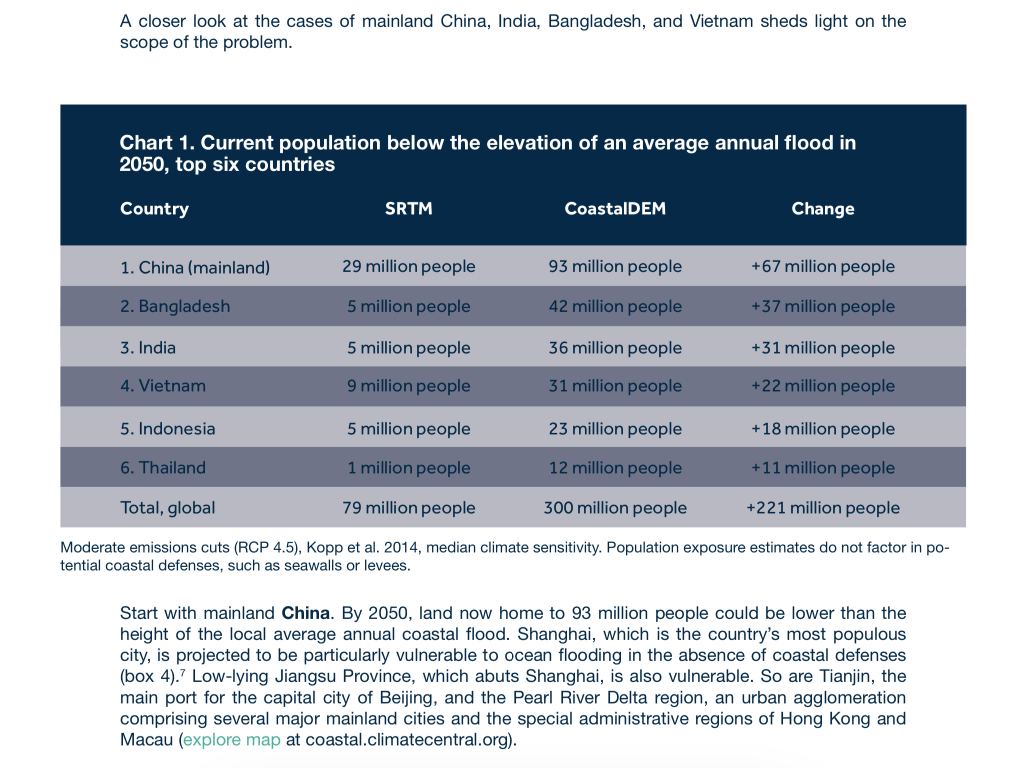A new study by Climate Central called Flooded Future shows that 300 million people will be affected by sea level rise flooding once yearly by 2050. This is almost four times as much as was estimated from previous satellite data, which gave 78 million. Furthermore, in 2100, 190 million people will be flooded below the high tide line. Numbers in my article here are taken from the Nature Communications article linked to at the end.
Flooding estimates in the United States, parts of Europe, and Australia are not changed, because they are more accurate with direct surveys. But the rest of the world was measured by satellite, which often mistook tree heights and building heights for ground levels. Using Artificial Intelligence, Climate Central now can give more accurate measures. The increased projections of flooding are largely in Asia.
All is not lost, since 110 million people who live below high tide are already protected by dikes. 250 million currently are below average flood levels. All dikes have maintenance needs.
The satellite estimates are from the SRTM Shuttle Radar Topography Mission, and are estimated to be about 6 feet too high, worldwide. The US uses laser technology lidar for the best measurements.
The projections use the optimistic climate action future called medium emission growth or RCP4.5, which follows the Paris Agreements goal of maximizing at 2.0º Centigrade rise in temperature, or 3.6º F. We have already risen 1.0º C over pre-industrial times, so we only have 1.0º C or 1.8ºF to go.
Here are the main nations affected by the news projections, taken from the report. The column SRTM was the older estimate. CoastalDEM is the new neural network calculation. The last column is the gain in population affected by the new estimate.
The top 6 countries’ population affected by yearly flooding in the table adds up to 237 million, or 79% of the world total. China itself, the largest country affected, with 93 million, is 31% of the world total of 300 million.
In 2050 under the “business as usual” or high emissions RCP8.5, 150 (140-170) million will be flooded yearly, and 300 (280-330) million will be under permanent high tide. The numbers in parentheses are the ranges of the estimate. The previous SRTM estimates were only 80 million for flooded yearly, and 39 million for flooded permanently.
In 2050 under almost total emissions reduction, RCP2.6, again 150 million will be flooded yearly, and 300 million will be under permanent high tide. So the 2050 numbers are the same under either emission scenarios.
The permanent flooding in 2100 under RCP4.5 is projected to affect 200 million people. Yearly flooding will affect 360 million.
Under ‘business-as-usual’ RCP8.5 the permanent flooding in 2100 estimate is 230 million. Yearly flooding will affect 390 million.
With eventual almost total emission reduction, RCP2.6, the number affected by permanent flooding in 2100 is still 190 million, and yearly flooding will affect 340 million.
There are many caveats to the present accuracy, and they lead to more vulnerable areas and greater population affected even in the same area.
Tens of trillions of dollars of flood damage are expected yearly by 2100, or trillions yearly will have to be spent on dikes, where useful.
This is the link to the Flooded Future report.
The scientific publication is in Nature Communications 10, article number 4844 (2019) by Scott A. Kulp and Benjamin H. Strauss at https://rdcu.be/bVUt0

